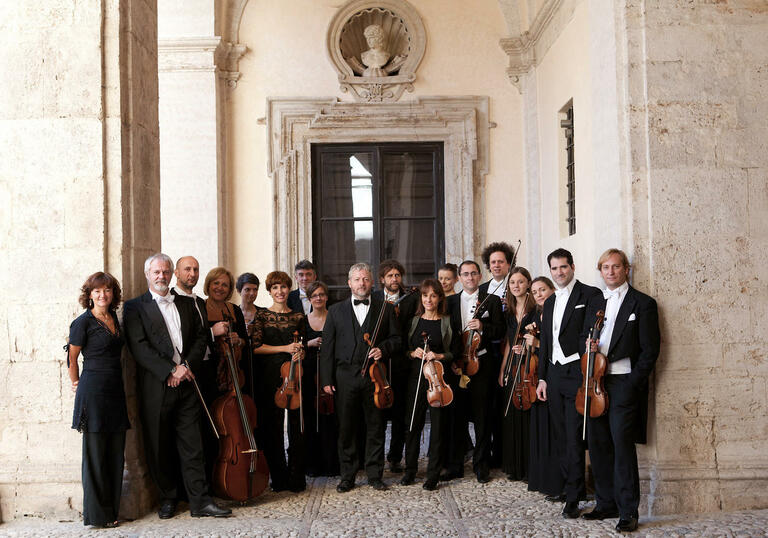
Programme and performers
Antonio Vivaldi Violin Concerto in E major, La primavera (Spring)
1. Allegro
2. Largo
3. Allegro
Henry Purcell Suite from The Fairy Queen
‘Thus the ever Grateful Spring’
‘See my many colour’d fields’
Dance for the followers of Night
‘See, even Night herself is here’
Dance of the haymakers
‘Now the Night is chas’d away’
Antonio Vivaldi Violin Concerto in G minor, L’estate (Summer)
1. Allegro non molto
2. Adagio – Presto
3. Presto
George Frideric Handel ‘Like clouds, stormy winds them impelling’ from The Triumph of Time and Truth
George Frideric Handel ‘Finché d’un zeffiro soave’ from Ezio
Antonio Vivaldi Violin Concerto in F major, L’autumno (Autumn)
1. Allegro
2. Adagio molto
3. Allegro
George Frideric Handel ‘Da tempeste’ from Giulio Cesare
Antonio Vivaldi Violin Concerto in F minor, L’inverno (Winter)
1. Allegro non molto
2. Largo
3. Allegro
Europa Galante
Fabio Biondi violin/director
Nardus Williams soprano
Song texts
‘Thus the ever grateful Spring’
Thus the ever grateful Spring,
Does her yearly tribute bring;
All your sweets before him lay,
Then round his altar sing, and play.
‘See my many colour’d fields’
See my many colour’d fields
And loaded trees my will obey;
All the fruit that Autumn yields,
I offer to the God of Day.
Dance for the followers of Night
‘See, even Night herself is here’
See, even Night herself is here,
To favour your design;
And all her peaceful train is near,
That men to sleep incline.
Let noise and care,
Doubt and despair,
Envy and spite
(the fiends’ delight)
Be ever banish’d hence.
Let soft repose,
Her eyelids close;
And murmuring streams,
Bring pleasing dreams;
Let nothing stay to give offence.
Dance of the haymakers
‘Now the Night is chas’d away’
Now the night is chas’d away,
All salute the rising sun;
’Tis that happy, happy day,
The birthday of King Oberon.
Libretto adapted from William Shakespeare’s A Midsummer Night’s Dream
Artist biographies
Europa Galante was formed in 1989 by its artistic director Fabio Biondi, with the aim of creating an Italian instrumental ensemble to interpret Baroque and Classical repertoire on period instruments. It rapidly achieved success with the release of its first recording of Vivaldi concertos. The ensemble subsequently built on this, with a substantial discography that has received many prestigious awards.
It has appeared at many leading theatres and concert halls, including Milan’s Teatro alla Scala, Amsterdam Concertgebouw, Royal Albert Hall, Théâtre des Champs-Élysées in Paris, Pierre Boulez Saal in Berlin, Madrid’s Auditorio Nacional, Lincoln Center and Carnegie Hall in New York, Walt Disney Concert Hall in Los Angeles and the Sydney Opera House.
Major festivals at which Europa Galante has appeared included the BBC Proms, Edinburgh International Festival, Baalbek Festival in Lebanon, the Spring Festival at the National Center of Performing Arts in Beijing and Hong Kong Arts Festival.
In addition to performances of the most famous works of the Italian Baroque repertoire, not least Vivaldi’s Four Seasons, the ensemble has also presented rediscovered treasures of the 1700s. In Italy the ensemble collaborated with the National Academy of Santa Cecilia in the reconstruction of oratorios by Antonio Caldara, Leonardo Leo and Gian Francesco de Mayo, as well as Alessandro Scarlatti’s works such as Carlo re d’Allemagna, Il trionfo dell’onore and Massimo Puppieno. This research work has garnered awards, including the prestigious Abbiati Award, awarded to Europa Galante and Fabio Biondi in 2002 for Il trionfo dell’onore and in 2008 for the restoration of Haydn’s Filemone e Bauci.
The group’s interest ranges beyond the Baroque and Classical eras, and in 2001 it made its first foray into bel canto repertoire with a performance of Bellini’s Norma on original instruments at the Verdi Festival. This marked the beginning of a path of re-evaluating Italian 19th-century music, which has included Bellini’s I Capuleti e i Montecchi and Donizetti’s Anna Bolena at the Rieti Festival and Rossini’s La Cenerentola at the Bremen Festival. Since 2016 the ensemble has been a regular at the Chopin Festival in Warsaw, presenting works by Bellini, Donizetti and Verdi’s Macbeth and Il corsaro. There, it has also performed Stanisław Moniuszko’s Halka, Flis, Hrabina and Verbum nobile.
Europa Galante is made up of musicians who, under the guidance of Fabio Biondi, have achieved through years of work and mutual understanding a common vision and passion for what they do. This has led to an increasing focus on chamber music, which ranges from Italian Baroque sonatas to the quintets of Boccherini and the unpublished quartets of Carlo Monza.
The ensemble is resident at the Teatro Due Foundation in Parma.
